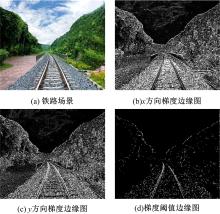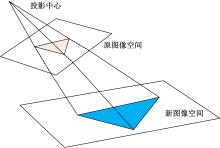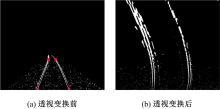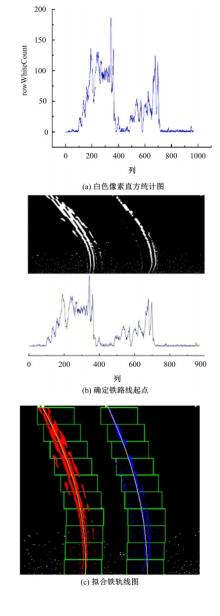Journal of Jilin University(Engineering and Technology Edition) ›› 2022, Vol. 52 ›› Issue (10): 2405-2418.doi: 10.13229/j.cnki.jdxbgxb20210266
Detection of foreign object intrusion in railway region of interest based on lightweight network
Yong CHEN1,2( ),Chen-tao LU1,Zhen WANG1
),Chen-tao LU1,Zhen WANG1
- 1.School of Electronic and Information Engineering,Lanzhou Jiaotong University,Lanzhou 730070,China
2.Gansu Provincial Engineering Research Center for Artificial Intelligence and Graphics & Image Processing,Lanzhou Jiaotong University,Lanzhou 730070,China
CLC Number:
- TP391.4
| 1 | He D Q, Yao Z K, Jiang Z, et al. Detection of foreign matter on high-speed train underbody based on deep learning[J]. IEEE Access, 2019, 7: 183838-183846. |
| 2 | 王瑞, 史天运, 包云. 一种基于视频的铁路周界入侵检测智能综合识别技术研究[J].仪器仪表学报, 2020, 41(9): 188-195. |
| Wang Rui, Shi Tian-yun, Bao Yun. Research on an intelligent comprehensive recognition technology in railway perimeter intrusion detection based on video[J]. Chinese Journal of Scientific Instrument, 2020, 41(9): 188-195. | |
| 3 | Simona F, Eduardo F, Francesca D C, et al. Railways track characterization using ground penetrating radar [J].Procedia Engineering, 2016, 143:1193-1200. |
| 4 | Dhiraj S, Omaka R. Object drop detection on railway track through rayleigh wave sensing using laser vibrometer[J].IEEE Transactions on Vehicular Technology, 2018, 67(10): 9158-9172. |
| 5 | Alexey T, Aleksandrs R, Viktors M. Assessment of cracks in pre-stressed concrete railway sleepers by ultrasonic testing[J]. Procedia Computer Science, 2019, 149: 324-330. |
| 6 | Niu H X, Hou T. Fast detection study of foreign object intrusion on railway track[J]. Archives of Transport, 2018, 46(3): 79-89. |
| 7 | 徐谦, 李颖, 王刚. 基于深度学习的行人和车辆检测[J]. 吉林大学学报: 工学版, 2019, 49(5): 1661-1667. |
| Xu Qian, Li Ying, Wang Gang. Pedestrian-vehicle detection based on deep learning[J]. Journal of Jilin University (Engineering and Technology Edition), 2019, 49(5): 1661-1667. | |
| 8 | Li Y D, Dong H, Li H G,et al. Multi-block SSD based on small object detection for UAV railway scene surveillance[J]. Chinses Journal of Aeronautics, 2020, 33(6): 1747-1755. |
| 9 | 徐岩, 陶慧青, 虎丽丽. 基于Faster R-CNN网络模型的铁路异物侵限检测算法研究[J]. 铁道学报, 2020, 42(5): 91-98. |
| Xu Yan, Tao Hui-qing, Hu Li-li. Railway foreign body intrusion detection based on faster R-CNN network model[J]. Journal of the China Railway Society, 2020, 42(5): 91-98. | |
| 10 | 华夏, 王新晴, 王东, 等. 基于改进SSD的交通大场景多目标检测[J].光学学报, 2018, 38(12): 221-231. |
| Hua Xia, Wang Xin-qing, Wang Dong, et al. Multi-objective detection of traffic scene based on improved SSD[J]. Acta Optica Sinica, 2018, 38(12): 221-231. | |
| 11 | Qi H Y, Xu T H, Wang G, et al. MYOLOv3-Tiny: a new convolutional neural network architecture for real-time detection of track fasteners[J]. Computers in Industry, 2020, 123: No. 103303. |
| 12 | 王玮, 朱力强. 基于特征图裁剪的高铁周界入侵实时检测算法[J].铁道学报, 2019, 41(9): 74-80. |
| Wang Wei, Zhu Li-qiang. Real-time instrusion detection algorithm for high-speed railway based on feature map pruning[J]. Journal of the China Railway Society, 2019, 41(9): 74-80. | |
| 13 | Daniel S R, Ivan O P, Arturo O L. Automatic region of interest segmentation for breast thermogram image classification[J]. Pattern Recognition Letters, 2020, 135: 72-81. |
| 14 | Karakose M, Yaman O, Murat K, et al. A new approach for condition monitoring and detection of rail components and rail track in railway[J]. International Journal of Computational Intelligence Systems, 2018, 11(1): 830-845. |
| 15 | Huang Y P, Li Y W, Ci W Y. Lane detection based on inverse perspective transformation and kalman filter[J]. KSII Transactions on Internet and Information Systems, 2018, 12(2): 643-661. |
| 16 | . 标准轨距铁路建筑限界 [S]. |
| 17 | Redmon J, Farhadi A. YOLOv3: an Incremental Improvement[C]∥IEEE Conference on Computer Vision and Pattern Recognition (CVPR), Salt Lake City, 2018. |
| 18 | Zhang X L, Dong X P, Wei Q J, et al. Real-time object detection algorithm based on improved YOLOv3[J]. Journal of Electronic Imaging, 2019, 28(5): No. 053022. |
| 19 | Liu Z, Li J, Shen Z, et al. Learning efficient convolutional networks through network slimming[C]∥Proceedings of 2017 IEEE International Conference on Computer Vision (ICCV), Venice, Italy, 2017: 2736-2744. |
| 20 | 李新春, 王藜谚, 王浩童. 基于3DCNN的CSI-cluster室内指纹定位算法[J]. 重庆邮电大学学报:自然科学版, 2020, 32(3): 345-355. |
| Li Xin-chun, Wang Li-yan, Wang Hao-tong. CSI-cluster indoor fingerprint localization algorithm based on 3DCNN[J]. Journal of Chongqing University of Posts and Telecommunications (Natural Science Edition), 2020, 32(3): 345-355. | |
| 蔡哲栋, 应娜, 郭春生, 等.YOLOv3剪枝模型的多人姿态估计[J]. 中国图象图形学报, 2021, 26(4): 837-846. | |
| Cai Zhe-dong, Ying Na, Guo Chun-sheng, et al. Research on multiperson pose estimation combined with YOLOv3 pruning model[J]. Journal of Image and Graphics, 2021, 26(4): 837-846. | |
| 22 | 刘高天, 段锦, 范祺, 等. 基于改进RFBNet算法的遥感图像目标检测[J]. 吉林大学学报:理学版, 2021, 59(5): 1188-1198. |
| Liu Gao-tian, Duan Jin, Fan Qi, et al. Target detection for remote sensing image based on improved RFBNet algorithm[J]. Journal of Jilin University (Science Edition), 2021, 59(5): 1188-1198. | |
| 袁梅, 全太锋, 黄俊, 等. 基于卷积神经网络的烟雾检测[J]. 重庆邮电大学学报:自然科学版, 2020, 32(4): 620-629. | |
| Yuan Mei, Quan Tai-feng, Huang Jun, et al. Smoke detection based on convolutional neural network[J]. Journal of Chongqing University of Posts and Telecommunications (Natural Science Edition), 2020, 32(4): 620-629. |
| [1] | Feng-feng ZHOU,Hai-yang ZHU. SEE: sense EEG⁃based emotion algorithm via three⁃step feature selection strategy [J]. Journal of Jilin University(Engineering and Technology Edition), 2022, 52(8): 1834-1841. |
| [2] | Tian BAI,Ming-wei XU,Si-ming LIU,Ji-an ZHANG,Zhe WANG. Dispute focus identification of pleading text based on deep neural network [J]. Journal of Jilin University(Engineering and Technology Edition), 2022, 52(8): 1872-1880. |
| [3] | Fu-heng QU,Tian-yu DING,Yang LU,Yong YANG,Ya-ting HU. Fast image codeword search algorithm based on neighborhood similarity [J]. Journal of Jilin University(Engineering and Technology Edition), 2022, 52(8): 1865-1871. |
| [4] | Gui-he QIN,Jun-feng HUANG,Ming-hui SUN. Text input based on two⁃handed keyboard in virtual environment [J]. Journal of Jilin University(Engineering and Technology Edition), 2022, 52(8): 1881-1888. |
| [5] | Yong-hui SHANG,Lin-rong XU,Zhao-feng CHEN. Consolidation characteristics and influencing factors of rigid pile-raft foundation of high-speed railway [J]. Journal of Jilin University(Engineering and Technology Edition), 2022, 52(7): 1588-1597. |
| [6] | Jun WANG,Yan-hui XU,Li LI. Data fusion privacy protection method with low energy consumption and integrity verification [J]. Journal of Jilin University(Engineering and Technology Edition), 2022, 52(7): 1657-1665. |
| [7] | Feng-feng ZHOU,Yi-chi ZHANG. Unsupervised feature engineering algorithm BioSAE based on sparse autoencoder [J]. Journal of Jilin University(Engineering and Technology Edition), 2022, 52(7): 1645-1656. |
| [8] | Yao-long KANG,Li-lu FENG,Jing-an ZHANG,Fu CHEN. Outlier mining algorithm for high dimensional categorical data streams based on spectral clustering [J]. Journal of Jilin University(Engineering and Technology Edition), 2022, 52(6): 1422-1427. |
| [9] | Wen-jun WANG,Yin-feng YU. Automatic completion algorithm for missing links in nowledge graph considering data sparsity [J]. Journal of Jilin University(Engineering and Technology Edition), 2022, 52(6): 1428-1433. |
| [10] | Xue-yun CHEN,Xue-yu BEI,Qu YAO,Xin JIN. Pedestrian segmentation and detection in multi-scene based on G-UNet [J]. Journal of Jilin University(Engineering and Technology Edition), 2022, 52(4): 925-933. |
| [11] | Shi-min FANG. Multiple source data selective integration algorithm based on frequent pattern tree [J]. Journal of Jilin University(Engineering and Technology Edition), 2022, 52(4): 885-890. |
| [12] | Da-xiang LI,Meng-si CHEN,Ying LIU. Spontaneous micro-expression recognition based on STA-LSTM [J]. Journal of Jilin University(Engineering and Technology Edition), 2022, 52(4): 897-909. |
| [13] | Ming LIU,Yu-hang YANG,Song-lin ZOU,Zhi-cheng XIAO,Yong-gang ZHANG. Application of enhanced edge detection image algorithm in multi-book recognition [J]. Journal of Jilin University(Engineering and Technology Edition), 2022, 52(4): 891-896. |
| [14] | Xiao-hui WEI,Yan-wei MIAO,Xing-wang WANG. Rhombus sketch: adaptive and more accurate sketch for streaming data [J]. Journal of Jilin University(Engineering and Technology Edition), 2022, 52(4): 874-884. |
| [15] | Xue WANG,Zhan-shan LI,Ying-da LYU. Medical image segmentation based on multi⁃scale context⁃aware and semantic adaptor [J]. Journal of Jilin University(Engineering and Technology Edition), 2022, 52(3): 640-647. |
|
||































